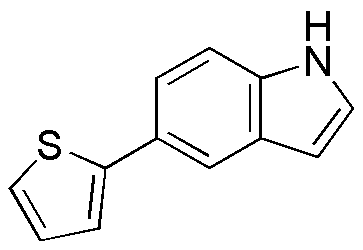5-(2-Thienyl)-1H-indole is widely utilized in research focused on:
- Pharmaceutical Development: This compound serves as a key building block in the synthesis of various pharmaceuticals, particularly in developing new drugs that target neurological disorders.
- Organic Electronics: Its unique electronic properties make it suitable for applications in organic light-emitting diodes (OLEDs) and organic solar cells, enhancing energy efficiency and performance.
- Material Science: Utilized in creating advanced materials, it contributes to the development of polymers and composites with enhanced thermal and mechanical properties.
- Biological Research: The compound is employed in studies investigating its potential as a fluorescent probe, aiding in cellular imaging and tracking biological processes.
- Agrochemicals: It has applications in the formulation of agrochemicals, particularly in developing new pesticides that are more effective and environmentally friendly.
General Information
Properties
Safety and Regulations
Applications
5-(2-Thienyl)-1H-indole is widely utilized in research focused on:
- Pharmaceutical Development: This compound serves as a key building block in the synthesis of various pharmaceuticals, particularly in developing new drugs that target neurological disorders.
- Organic Electronics: Its unique electronic properties make it suitable for applications in organic light-emitting diodes (OLEDs) and organic solar cells, enhancing energy efficiency and performance.
- Material Science: Utilized in creating advanced materials, it contributes to the development of polymers and composites with enhanced thermal and mechanical properties.
- Biological Research: The compound is employed in studies investigating its potential as a fluorescent probe, aiding in cellular imaging and tracking biological processes.
- Agrochemicals: It has applications in the formulation of agrochemicals, particularly in developing new pesticides that are more effective and environmentally friendly.
Documents
Safety Data Sheets (SDS)
The SDS provides comprehensive safety information on handling, storage, and disposal of the product.
Product Specification (PS)
The PS provides a comprehensive breakdown of the product’s properties, including chemical composition, physical state, purity, and storage requirements. It also details acceptable quality ranges and the product's intended applications.
Certificates of Analysis (COA)
Search for Certificates of Analysis (COA) by entering the products Lot Number. Lot and Batch Numbers can be found on a product’s label following the words ‘Lot’ or ‘Batch’.
*Catalog Number
*Lot Number
Certificates Of Origin (COO)
This COO confirms the country where the product was manufactured, and also details the materials and components used in it and whether it is derived from natural, synthetic, or other specific sources. This certificate may be required for customs, trade, and regulatory compliance.
*Catalog Number
*Lot Number
Safety Data Sheets (SDS)
The SDS provides comprehensive safety information on handling, storage, and disposal of the product.
DownloadProduct Specification (PS)
The PS provides a comprehensive breakdown of the product’s properties, including chemical composition, physical state, purity, and storage requirements. It also details acceptable quality ranges and the product's intended applications.
DownloadCertificates of Analysis (COA)
Search for Certificates of Analysis (COA) by entering the products Lot Number. Lot and Batch Numbers can be found on a product’s label following the words ‘Lot’ or ‘Batch’.
*Catalog Number
*Lot Number
Certificates Of Origin (COO)
This COO confirms the country where the product was manufactured, and also details the materials and components used in it and whether it is derived from natural, synthetic, or other specific sources. This certificate may be required for customs, trade, and regulatory compliance.


